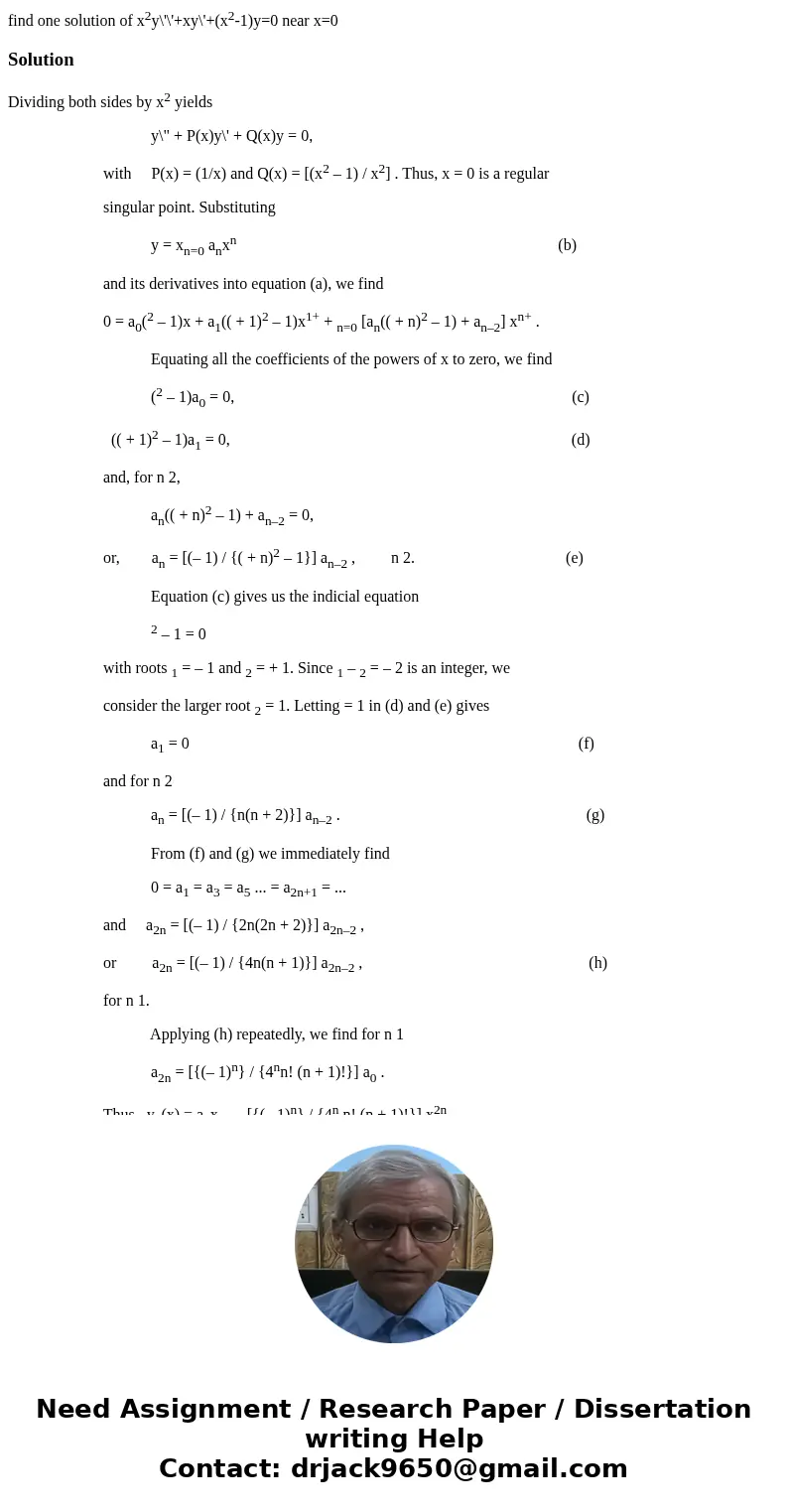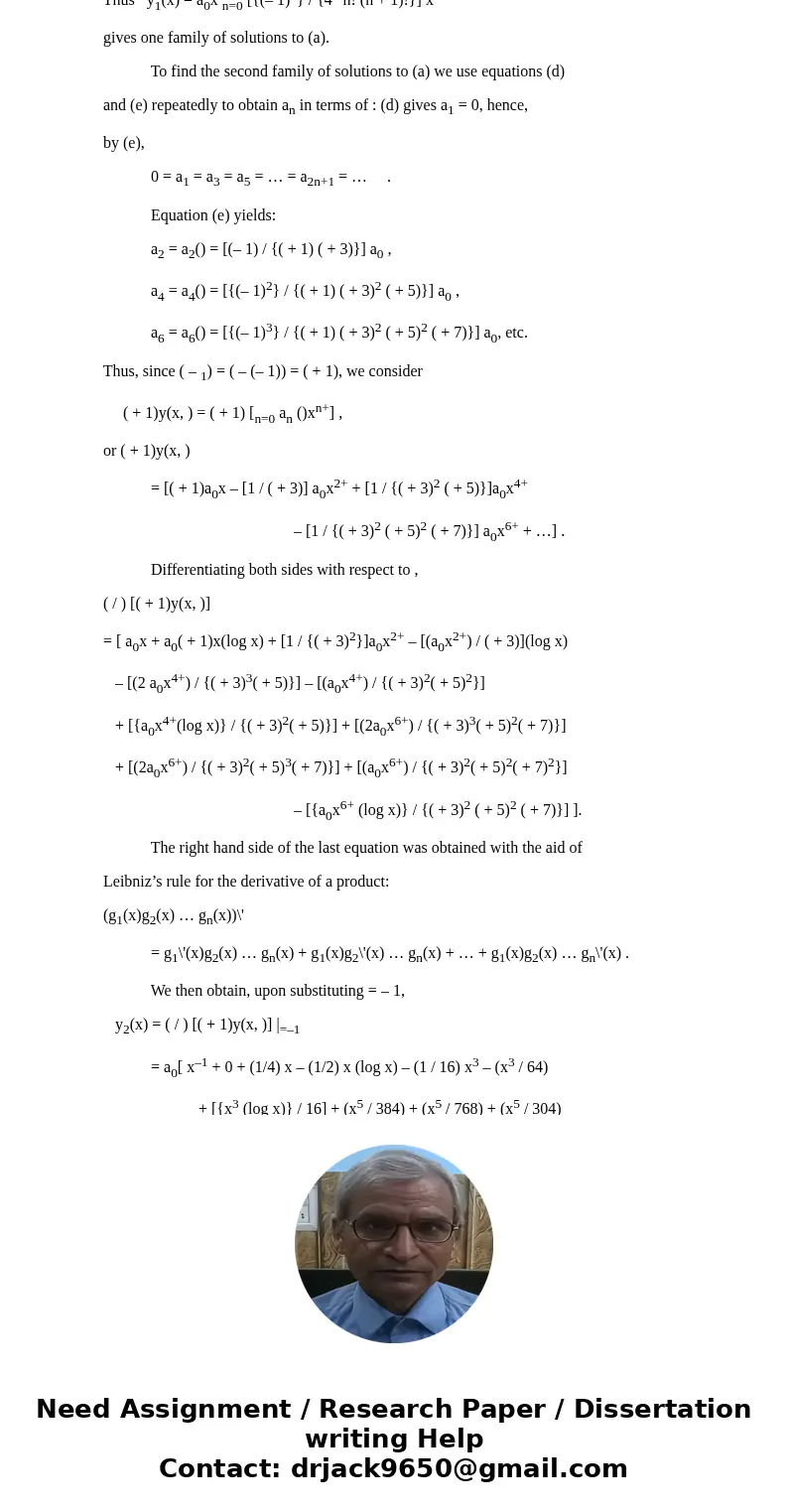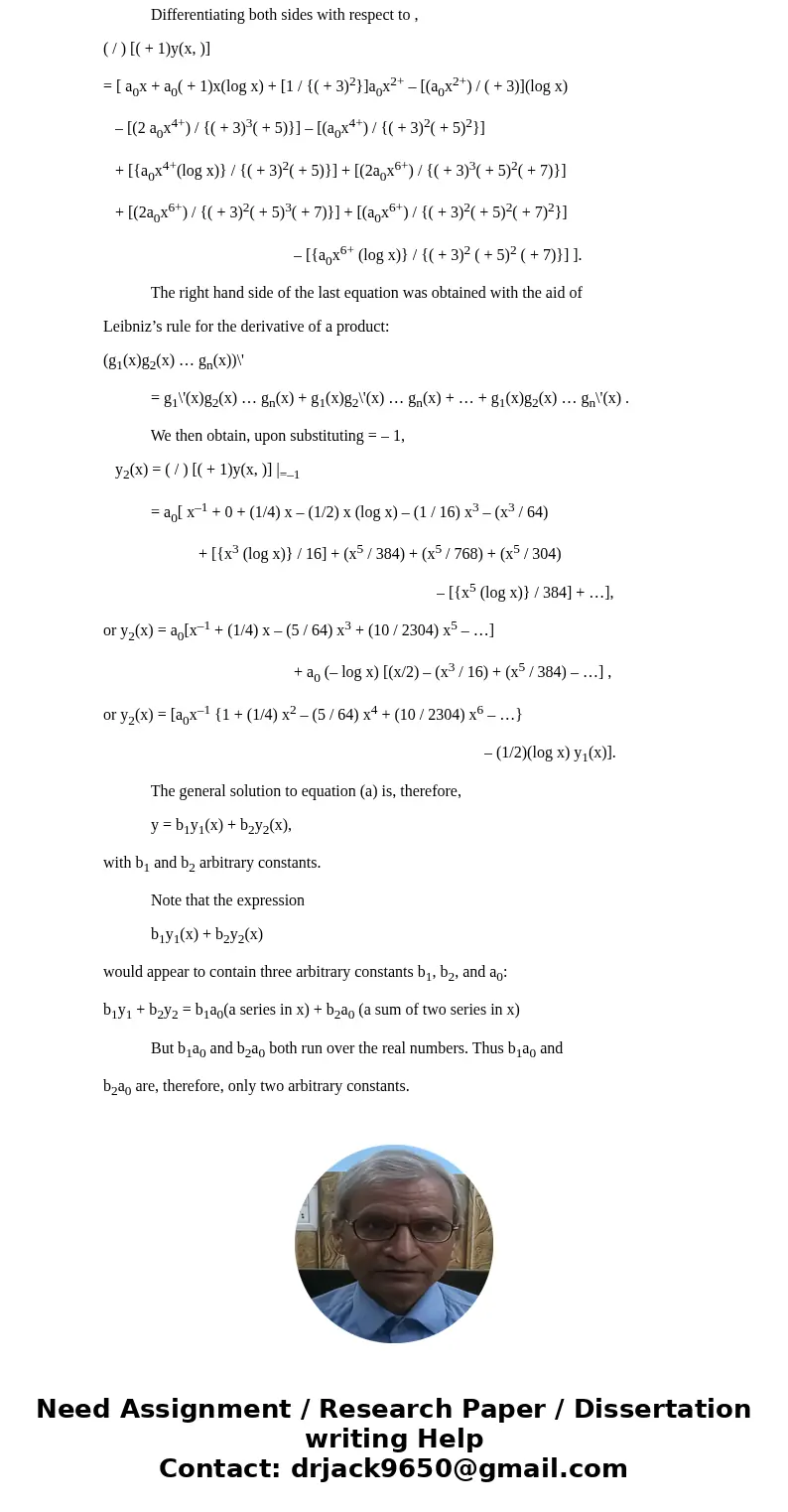find one solution of x2yxyx21y0 near x0SolutionDividing both
find one solution of x2y\'\'+xy\'+(x2-1)y=0 near x=0
Solution
Dividing both sides by x2 yields
y\" + P(x)y\' + Q(x)y = 0,
with P(x) = (1/x) and Q(x) = [(x2 – 1) / x2] . Thus, x = 0 is a regular
singular point. Substituting
y = xn=0 anxn (b)
and its derivatives into equation (a), we find
0 = a0(2 – 1)x + a1(( + 1)2 – 1)x1+ + n=0 [an(( + n)2 – 1) + an–2] xn+ .
Equating all the coefficients of the powers of x to zero, we find
(2 – 1)a0 = 0, (c)
(( + 1)2 – 1)a1 = 0, (d)
and, for n 2,
an(( + n)2 – 1) + an–2 = 0,
or, an = [(– 1) / {( + n)2 – 1}] an–2 , n 2. (e)
Equation (c) gives us the indicial equation
2 – 1 = 0
with roots 1 = – 1 and 2 = + 1. Since 1 – 2 = – 2 is an integer, we
consider the larger root 2 = 1. Letting = 1 in (d) and (e) gives
a1 = 0 (f)
and for n 2
an = [(– 1) / {n(n + 2)}] an–2 . (g)
From (f) and (g) we immediately find
0 = a1 = a3 = a5 ... = a2n+1 = ...
and a2n = [(– 1) / {2n(2n + 2)}] a2n–2 ,
or a2n = [(– 1) / {4n(n + 1)}] a2n–2 , (h)
for n 1.
Applying (h) repeatedly, we find for n 1
a2n = [{(– 1)n} / {4nn! (n + 1)!}] a0 .
Thus y1(x) = a0x n=0 [{(– 1)n} / {4n n! (n + 1)!}] x2n
gives one family of solutions to (a).
To find the second family of solutions to (a) we use equations (d)
and (e) repeatedly to obtain an in terms of : (d) gives a1 = 0, hence,
by (e),
0 = a1 = a3 = a5 = … = a2n+1 = … .
Equation (e) yields:
a2 = a2() = [(– 1) / {( + 1) ( + 3)}] a0 ,
a4 = a4() = [{(– 1)2} / {( + 1) ( + 3)2 ( + 5)}] a0 ,
a6 = a6() = [{(– 1)3} / {( + 1) ( + 3)2 ( + 5)2 ( + 7)}] a0, etc.
Thus, since ( – 1) = ( – (– 1)) = ( + 1), we consider
( + 1)y(x, ) = ( + 1) [n=0 an ()xn+] ,
or ( + 1)y(x, )
= [( + 1)a0x – [1 / ( + 3)] a0x2+ + [1 / {( + 3)2 ( + 5)}]a0x4+
– [1 / {( + 3)2 ( + 5)2 ( + 7)}] a0x6+ + …] .
Differentiating both sides with respect to ,
( / ) [( + 1)y(x, )]
= [ a0x + a0( + 1)x(log x) + [1 / {( + 3)2}]a0x2+ – [(a0x2+) / ( + 3)](log x)
– [(2 a0x4+) / {( + 3)3( + 5)}] – [(a0x4+) / {( + 3)2( + 5)2}]
+ [{a0x4+(log x)} / {( + 3)2( + 5)}] + [(2a0x6+) / {( + 3)3( + 5)2( + 7)}]
+ [(2a0x6+) / {( + 3)2( + 5)3( + 7)}] + [(a0x6+) / {( + 3)2( + 5)2( + 7)2}]
– [{a0x6+ (log x)} / {( + 3)2 ( + 5)2 ( + 7)}] ].
The right hand side of the last equation was obtained with the aid of
Leibniz’s rule for the derivative of a product:
(g1(x)g2(x) … gn(x))\'
= g1\'(x)g2(x) … gn(x) + g1(x)g2\'(x) … gn(x) + … + g1(x)g2(x) … gn\'(x) .
We then obtain, upon substituting = – 1,
y2(x) = ( / ) [( + 1)y(x, )] |=–1
= a0[ x–1 + 0 + (1/4) x – (1/2) x (log x) – (1 / 16) x3 – (x3 / 64)
+ [{x3 (log x)} / 16] + (x5 / 384) + (x5 / 768) + (x5 / 304)
– [{x5 (log x)} / 384] + …],
or y2(x) = a0[x–1 + (1/4) x – (5 / 64) x3 + (10 / 2304) x5 – …]
+ a0 (– log x) [(x/2) – (x3 / 16) + (x5 / 384) – …] ,
or y2(x) = [a0x–1 {1 + (1/4) x2 – (5 / 64) x4 + (10 / 2304) x6 – …}
– (1/2)(log x) y1(x)].
The general solution to equation (a) is, therefore,
y = b1y1(x) + b2y2(x),
with b1 and b2 arbitrary constants.
Note that the expression
b1y1(x) + b2y2(x)
would appear to contain three arbitrary constants b1, b2, and a0:
b1y1 + b2y2 = b1a0(a series in x) + b2a0 (a sum of two series in x)
But b1a0 and b2a0 both run over the real numbers. Thus b1a0 and
b2a0 are, therefore, only two arbitrary constants.



 Homework Sourse
Homework Sourse